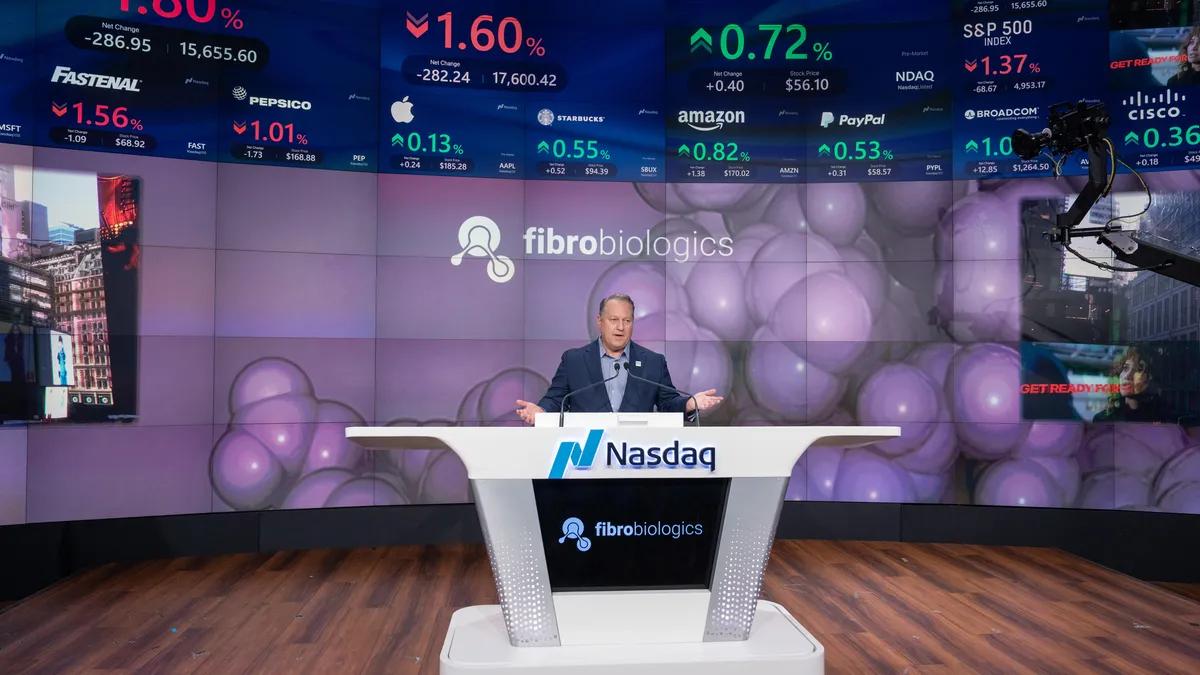Welcome to Biotech Spotlight, a series featuring companies with breakthrough technologies and strategies. Today, we're looking at Graphite Bio, a gene editing company advancing a treatment for sickle cell disease that makes use of precise methods of targeted gene integration.
In focus with: Josh Lehrer, Graphite Bio CEO
Graphite Bio's vision: With its gene editing platform, Graphite is seeking to bring its lead candidate for sickle cell disease through early stage clinical trials, as well as preclinical therapies for other genetic conditions like beta-thalassemia, alpha-1 antitrypsin deficiency, X-linked severe combined immunodeficiency syndrome and Gaucher disease. CEO Josh Lehrer also believes the company's platform could be used in collaboration with other companies to augment their gene editing capabilities.
Why it matters: CRISPR gene editing technology is still a rather new development in the life sciences, and many companies are looking to harness its potential to treat and even cure genetic diseases. Among those conditions is sickle cell disease, which affects almost 6.5 million people worldwide. Graphite's platform is designed to replace defective genes with a next-generation approach that could help reduce the side effects sometimes brought on by gene editing.
There is currently no cure for sickle cell disease besides risky bone marrow transplants reserved for children with a severe form of the disease. And the disease predominantly affects people of color with one out of every 365 Black or African-American births in the U.S. representing a case of sickle cell, according to the Centers for Disease Control and Prevention.
The company's strategy: Graphite is beginning a phase 1/2 study in patients with sickle cell disease using a gene editing platform that can rewrite DNA, changing the way proteins are expressed. The platform stands apart from others in its class by building on CRISPR technology to make therapies that more precisely replaces sections of genetic code with donor DNA to correct a single mutation.
At a glance: Lehrer says the No. 1 goal at Graphite is bringing forward the sickle cell treatment, screening and enrolling patients at Stanford University, the University of Alabama and Washington University, and adding more sites. The first patient data is expected to read out in 2023.
In PharmaVoice’s conversation with Lehrer, he discussed how Graphite’s technology provides a uniquely precise option for targeting genetic diseases, how challenges like manufacturing are one of the biggest hurdles in gene editing, and how the company approaches the social aspects of sickle cell disease even at this very early stage of research.
PharmaVoice: How does Graphite Bio's technology platform stand apart from the many others in the gene editing space?
Josh Lehrer: There are a lot of companies with a lot of different approaches in the gene editing space, and what we're doing is really unique in terms of our focus. It comes from a scientific approach developed at Stanford by our main founder Matt Porteus, who's one of the elder statesmen in the field. Going back to those early days prior to the discovery of CRISPR, the holy grail of gene editing was to actually rewrite genetic sequences to harness precision repair processes in the cell to provide a template and change DNA genotypes to the normal sequence and be a definitive cure for a range of genetic diseases.
The first generation of approaches don't do precision repair because it turns out to be a lot harder, and instead rely on the default, which is essentially cutting and breaking genes. [Porteus] stayed focused and asked how he could combine a set of tools to actually cure these diseases by returning DNA sequences to normal — so the way that we're doing that is building on CRISPR technology. We're focusing initially on hematopoietic stem cells because we know that these kinds of cells can be one-time lifelong cures. The traditional balance between error-prone repair and position repair has been 10 to one — and [Porteus] succeeded in inverting that to where we're getting as high as 70% precision repair.
What are some of the fundamental challenges for companies in the gene editing space?
One thing I've learned at Graphite as a gene editing company is that so much about what we're doing is dependent on the manufacturing. What we're doing now is a whole different level of complexity and the drug products we're manufacturing are living cells, so doing that successfully and reproducibly requires developing assays to confidently measure the quality of the drug product, and that's 90% of what's important.
The other thing that is a challenge for a small biotech is that funding is critical. You're so often thinking about the next data inflection right in front of you and what needs to be done in the next quarter or the next six months. And that's what we've been able to do — fortunately we're well capitalized and we have a very experienced team. So we have to really be planning now, just as we're getting into patients, for what changes and improvements we want to make in the process over time to get to a commercial process that can have a certain optimal impact.
How do you choose which therapeutic areas are best for your platform to succeed? Why is sickle cell disease the first target?
The platform has very broad potential. There's a very long list of diseases that we could apply this to, where you would want to correct a genetic lesion or replace a defective gene to offer a cure. Because we're starting with hematopoietic stem cells with the ability to change a mutant gene to a normal gene, sickle cell disease immediately rises to the top of the list in terms of the unmet need, the size of the patient population and just what we know about the genetics. We know that if allotransplant is the only way to cure this disease, which is replacing cells in the bone marrow of a patient with those from a normal sibling, that's always been viewed as the optimal way to cure sickle cell disease — to change at the DNA level sickle cells to normal cells. That's a definitive cure, and there aren't many other diseases where the current therapies are just woefully inadequate. There's nothing that prevents early mortality, and patients are still dying in their 40s despite new therapies.
Sickle cell disease affects people of color in a highly disproportionate way. At this early stage, what conversations do you have around access and the social issues associated with finding a cure for this disease?
We think about this a lot. We have a lot of people on the team who have worked in sickle cell for a while, and it was important that we have the technology and also a patient focus, bringing patients in and having discussions with them, thinking about how we explain this technology and how we're going to understand the challenges that they face, whether it's racial bias in the emergency room or access to care. It's vitally important, and having a mission-driven component to what we're doing is an important part of Graphite as a company.
To make an impact, we first have to be mindful of what we can actually positively impact today versus tomorrow. So we have to be very focused on proving that the science works and that this has the opportunity to potentially offer a cure to patients.































































